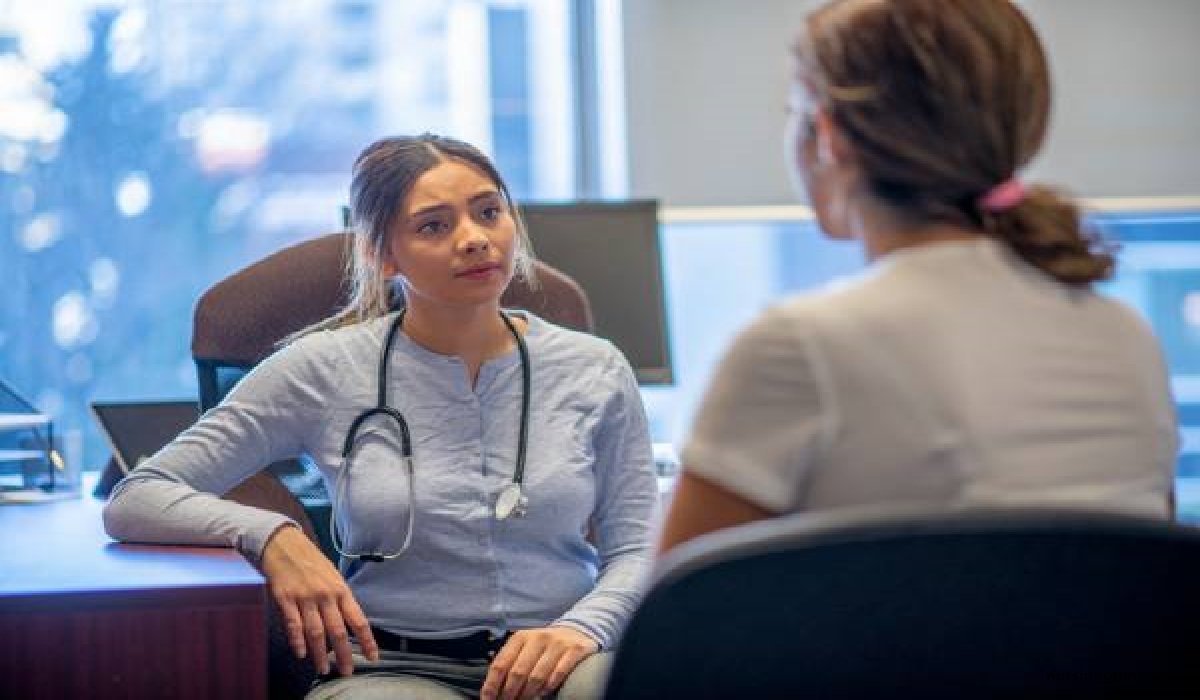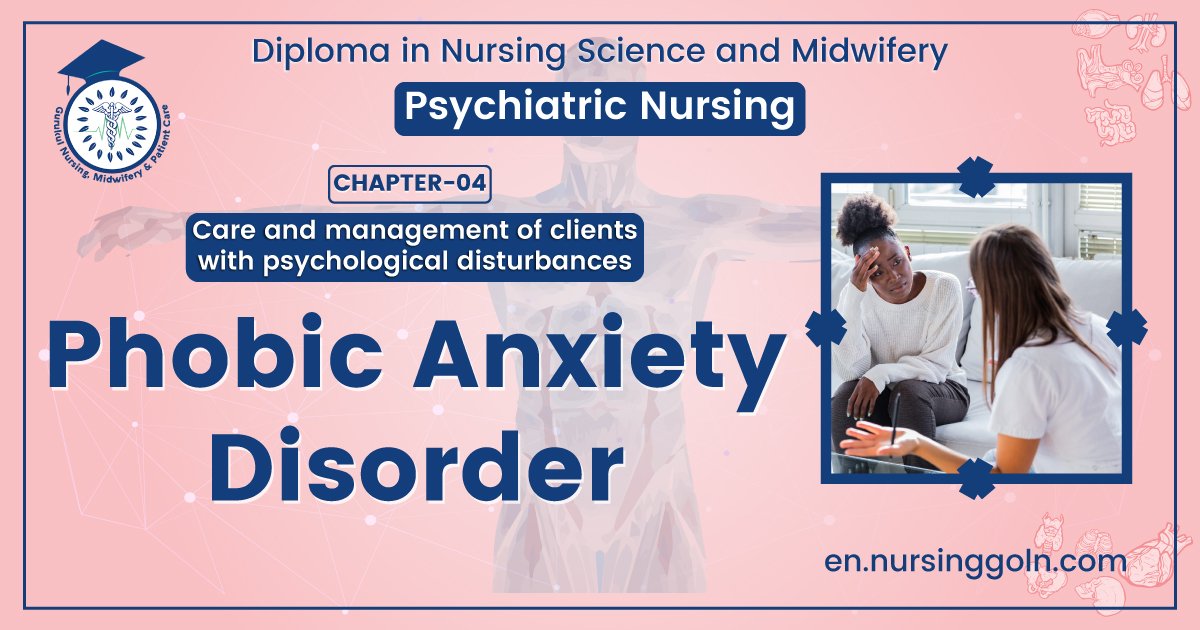Phobic anxiety disorder – This book covers the entire syllabus of “Psychiatric Nursing” prescribed by the Universities of Bangladesh- for Basic and diploma nursing students. We tried to accommodate the latest information and topics. This book is an examination-friendly setup according to the teachers’ lectures and examination questions.
At the end of the book previous university questions are given. We hope in touch with the book students’ knowledge will be upgraded and flourish. The unique way of presentation may make your reading of the book a pleasurable experience.

Phobic anxiety disorder
Phobia:
Persistent avoidance behaviour secondary to irrational fear of a specific object, activity or situation.
[Ref: K. Lalitha/1]
Or
A phobia is an abnormal or excessive fear of a particular object or situation, which leads to avoidance of it.
[Ref-Davidson’s 24 edition)
Criteria to define phobia:
1. Fear is out of proportion to the demands of the situation
2. Cannot be explained or reasoned away
3. Beyond voluntary control 4. Fear leads to an avoidance of the feared situation-Marks.
(Ref: KP Neeraja/1/Vol-2/436)
Classification of phobic anxiety disorder:
1. Agora phobia (with or without panic disorder)
2. Specific phobia (isolated phobias; simple phobia)
➤ Blood
➤ Animal
➤ Doctor
3. Social phobia-DSM-IV 4th edition
4. Phobic anxiety disorders (specified and unspecified)-ICD-10 (F40).
Some common phobic disorder:
| Name of the phobia | Meaning |
| Claustrophobia | Fear of closed spaces |
| Hematophobia | Fear of the sight of blood |
| Acrophobia | Fear of height |
| Gamophobia | Fear of marriage |
| Insectophobia | Fear of insects |
| Ailurophobe | Fear of cats |
| Cynophobia | Fear of dogs |
| Mysophobia | Fear of dirt |
| Nyctophobia | Fear of darkness |
| Thanatophobia | Fear of death |
| AIDS phobia | Fear of AIDS |
| Venereophobia | Fear of venereal diseases |
[Ref: S Nambi/24/571]
Causes of phobic disorder:
1. Brain chemistry combine with life experiences play a major role in the development of anxiety disorder and phobia
2. Arises from a combination of external events and internal predispositions
3. Certain objects may have a genetic predisposition/ heredity being associated with fear
4. Specific triggering event, e.g. traumatic experiences in early age
5. Psychodynamic theory.
[Ref: KP Neeraja/1/Vol-2/436]
Treatment of phobia:
A. Psychological:
- Reassurance & explanation.
- Psychotherapy.
- Behaviour therapy with desensitization in phobic anxiety.
- To expose the phobic situation using the technique of flooding – ie. exposing in a real situation or by using implosion -exposing to image photographs etc.
B. Physical/Somatic:
Drugs-
1. Anxiolytie: Benzodiazepine Used for short term
- Diazepam.
- Alprazolam
2. Antidepressants: is the drug of choice
- Amitryptyline
3. beta-blockers:
- Propranolol
[Ref-Davidson’s/24th edition)
A person with a phobic anxiety disorder will experience the following symptoms:
1. a sensation of uncontrollable anxiety when exposed to the source of fear
2. a feeling that the source of that fear must be avoided at all costs
3. not being able to function properly when exposed to the trigger
4. acknowledgment that the fear is irrational, unreasonable, and exaggerated, combined with an inability to control the feelings
A person is likely to experience feelings of panic and intense anxiety when exposed to the object of their phobia. The physical effects of these sensations can include;
- sweating
- abnormal breathing
- accelerated heartbeat
- trembling
- hot flushes or chills
- a choking sensation
- chest pains or tightness
- butterflies in the stomach
- pins and needles
- dry mouth
- confusion and disorientation
- nausea
- dizziness
- headache

Nursing Management
Nursing management of a patient with anxiety disorder include the following:
A. Nursing Assessment: Nursing assessment of a patient with anxiety disorder include:
- History: The client usually seeks treatment for panic disorder after he or she has experienced several panic attacks; usually, the client cannot identify any trigger for these events.
- General appearance and motor behavior: The client may appear entirely “normal” or may have signs of anxiety if he or she is apprehensive about having a panic attack in the next few moments.
- Mood and affect: Assessment of mood and affect may reveal that the client is anxious, worried, tense, depressed, serious, or sad. Thought processes and content: During a panic attack, the client is overwhelmed, believing that he or she is dying, losing control, or “going insane”; the client may even consider suicide.
- Sensorium and intellectual process: During a panic attack, the client may be confused and disoriented; he or she cannot take in environmental cues and respond appropriately.
B. Nursing Diagnosis: Based on the assessment data, the major nursing diagnosis are:
- Anxiety related to unconscious conflict about essential values and goals of life; situational or maturational crises.
- Fear related to phobic stimulus.
- Ineffective coping related to underdeveloped ego; punitive superego.
- Powerlessness related to fear of disapproval from others.
- Social isolation related to panic level of anxiety.
C. Nursing Care Planning and Goals
- Client will verbalize ways to intervene in escalating anxiety within 1 week.
- Client will be able to recognize symptoms of onset of anxiety and intervene before reaching the panic stage by time of discharge from treatment.
D. Nursing Interventions: The nursing interventions for anxiety disorders are:
- Stay calm and be nonthreatening: Maintain a calm, nonthreatening manner while working with client; anxiety is contagious and may be transferred from staff to client or vice versa.
- Assure client of safety: Reassure client of his or her safety and security, this can be conveyed by physical presence of the nurse; do not leave client alone at this time.
- Be clear and concise with words: Use simple words and brief messages, speak calmly and clearly, to explain hospital experiences to client, in an intensely anxious situation, client is unable to comprehend anything but the most elementary communication.
- Provide a non-stimulating environment: Keep immediate surroundings low in stimuli (dim lighting, few people and simple decor), a stimulating environment may increase level of anxiety.
- Administer medications as prescribed: Administer tranquilizing medication, as ordered by physician; assess medication for effectiveness and for adverse side effects.
- Recognize precipitating factors: When level of anxiety has been reduced, explore with client possible reasons for occurrence; recognition of precipitating factors is the first step in teaching client to interrupt escalation of anxiety.
- Encourage client to verbalize feelings: Encourage client to talk about traumatic experience under nonthreatening conditions; help client work through feelings of guilt related to the traumatic event; help client understand that this was an event to which most people would have responded in like manner.
E. Evaluation: The outcome criteria for Anxiety Disorders include:
- Client is able to maintain anxiety at level in which problem solving can be accomplished.
- Client is able to verbalize signs and symptoms of escalating anxiety.
- Client is able to demonstrate techniques for interrupting the progression of anxiety to the panic level.
F. Documentation Guidelines: Documentation guidelines include the following:
- Individual findings, including factors affecting, interactions, nature of social exchanges,
- specifics of individual behavior.
- Cultural and religious beliefs, and expectations.
- Plan of care.
- Teaching plan.
- Responses to interventions, teaching, and actions performed.
- Attainment or progress toward the desired outcome.
Specific phobia
A disorder characterized by irrational and persistent fear of an object or situation, along with a compelling desire to avoid it. Usually, it is the fear of harmless animals or objects and certain situations like, fear of insects, small animals, height, dark places, examinations, closed spaces, sight of blood, marriage travel, etc.
Example of specific phobia:
| Name of the phobia | Meaning |
| Claustrophobia | Fear of closed spaces |
| Hematophobia | Fear of the sight of blood |
| Acrophobia | Fear of height |
| Gamophobia | Fear of marriage |
| Insectophobia | Fear of insects |
| Ailurophobe | Fear of cats |
| Cynophobia | Fear of dogs |
| Mysophobia | Fear of dirt |
| Nyctophobia | Fear of darkness |
| Thanatophobia | Fear of death |
| AIDS phobia | Fear of AIDS |
| Venereophobia | Fear of venereal diseases |
Treatment:
1. Systematic desensitization therapy-some therapist will use virtual reality or imagery exercise gradually to desensitize patients to the feared entity.
2. Cognitive behavioural therapy: Therapist will make the client to understand the cycle of negative thought pattern and ways to change these patterns. Cognitive behaviour therapy will be conducted in group settings. The techniques include imaginal exposure, performance based exposure, cognitive restricting, home-work assignments, flooding, relaxation techniques.
3. Drug therapy: Antidepressants or anxiolytics, serotonin reuptake inhibitors.
4. Insight oriented psychotherapy, supportive psychotherapy: The client will understand the origin of phobia, phenomena of secondary gain, role of resistance and healthy way of dealing with anxiety provoking stimuli.
5. Social skill training: Role modelling and role playing.
[Ref: KP Neeraja/I/Vol-2/437-438)
Social phobia
A disorder characterized by fear of and desire to avoid situation in which the person might be exposed to scrutiny by others and might behave in an embarrassin or humiliating way. This is a fear of appearing shameful or stupid or of blushing in the presence of others.
Clinical features:
1. A marked and persistent fear of one or more social or performance situations in which the person is exposed to unfamiliar people or to possible scrutiny by others.
2. The individual fears that he or she will act in a way that will be humiliating or embarrassing.
3. Exposure to the feared social situation invariably provokes anxiety, which may take the form of a situational predisposed panic attack.
4. The avoidance, anxious, anticipation or distress in the feared situation interferes significantly with the person’s normal occupational, social or interpersonal functioning or there is marked distress about having phobia.
Types:
➤ General Social Phobia (Social anxiety disorder)
➤ Specific Social Phobia (Anxiety triggered only in specific situations)
General social phobia:
In general social phobia the symptoms may extend to psychosomatic manifestations of physical problems, and suffer full-fledged panic attacks with all the associated disabling symptoms.
Specific social phobia:
In specific phobias fear of single specific panic trigger, e.g. spiders, dogs are common in childhood. People with these phobias specifically have mild anxiety over that fear.
Differential diagnosis:
1. Generalized anxiety disorder
2. Panic disorder
3. Schizophrenia
4. Avoidant personality disorder
Treatment:
A. Psychological treatment:
1. Cognitive behaviour therapy.
2. Relaxation training,
3. Dynamic psychotherapy.
B. Drug treatment:
1. Specific serotonin reuptake inhibitors (SSRIs):
✓ Fluvoxamine.
✓ Paroxetine.
✓ Sertraline.
✓ Fluoxetine,
2. Mono amine oxidase inhibitors (MAOIs):
✓ Phenelzine.
✓ Atenolol.
[Ref-Michael Gelder/5/185-81]

Agoraphobia
A disorder characterized by fear of being alone in an open space (public place) and in crowds from which escape might be difficult. This condition is more incapacitating because it restricts the patient’s daily activities. The fear can become debilitating, and some individuals avoid going into any open space, traveling in aero planes or being in a crowd people with severe cases may decide never to leave their homes. Agoraphobia is often precipitated by stress, particularly interpersonal stress. It is far more common in women than in men.
Epidemiology:
One (1) year prevalence of agoraphobia without panic disorder 1 per cent (%) in menand 3.8 percent (%) in women.
Clinical features:
1. A generalized fear of leaving home or a familiar ‘safe’ area, followed by possible panic attacks.
2. There is a gradual restriction in normal day-to-day activities.
3. Certain times restriction will be more.
4. The person will reside in home only
5. These persons prefer to be accompanied by a family member or friend whenever they are leaving home.
6. Majority of phobic clients will not have any problem related to social functioning.
Differential diagnosis:
1. Generalized anxiety disorder
2. Panic disorder
3. Schizophrenia
4. Avoidant personality disorder
(Ref: S Nambi/2/571
Treatment:
1. Psychologiocal treatment:
- Exposure treatment.
- Cognitive behaviour therapy.
2. Medication:
- Short term: Anxiolytic drug specially alprazolam.
- Long term: Imipramine.
- PROBLEM BASED QUESTIONS
[Ref-Michael Gelder/5/188-91)
Most likely diagnosis: Anxiety neurosis.
Management outline: See above
Outcome of anxiety:
- Relapses are common and
- Become chronic.
Most likely psychiatric diagnosis: Panic disorder.
5 medical causes of such symptoms:
✓ Hyperthyroidism
✓ Paroxysmal arrhythmias
✓ Phaeochromocytoma
✓ Alcohol and benzodiazepine withdrawal
✓ Hypoglycaemia
✓ Temporal lobe epilepsy.
Management of panic disorder, See anxiety disorder.
Panic Disorder
“Panic attacks or panic disorders are characterized by unexpected or intermittent or sudden severe episodes of intense fear or terror or anxiety of serious consequences unrelated to particular stimuli in which the physical symptoms are more predominate and severe.”
Or
[Ref: KP Neeraja/1″/Vol-2/424)
Sudden & unpredictable attacks of severe anxiety usually accompanied by physical symptoms e.g. chest pain & palpitation.
Or
Panic disorder is a variant of anxiety disorder in which there is sudden & recurrent appearance of predominantly cardiovascular symptoms followed by complete remission.
[Ref-Davidson’s/24th edition)
Important features/central features of panic attacks:
➤ Sudden attacks of anxiety where physical symptoms become more evident and pre-dominate ➤ The person fears of a serious medical consequences like heart attack or even death.
Symptoms of panic disorder:
A. Physical symptoms:
1. Shortness of breath or dyspnoea
2. Tachycardia, palpitations, pounding of heart, sometimes these symptoms is so severe, that the person fears he/she is having heart attack
3. Chest pain or chest discomfort
4. Blurry vision
5. Shaking or trembling
6. Dizziness or unsteadiness, fainting
7. Nausea, bloating, indigestion
8. Abdominal discomfort or distress
9. Sweating or perspiration
10. Choking sensations or suffocating
11. Lump in throat
12. Feeling light headed
13. Pale, cold and clammy skin
14. Blushing or skin blotches
15. Feels urgency in urination and defecation
16. Easily fatigue
17. Muscle tension-pain or tightness of body (chest, neck, shoulders)
18. Numbness in arms and legs
19. Headache or migraine.
B. Behaviora/Emotional Manifestations:
1. Intense fear or dread which is generally irrational
2. Derealization (perceives danger is very real)
3. Depersonalization (being detached from oneself)
4. Often feels as if they are about to die or pass out
5. Fear of losing control or going crazy or mad
6. Hot or cold flushes
7. Reluctant to discuss their panic attacks with others
8. Paraesthesia (numbness or tingling sensations)
9. Unnecessary worry, impending sense of doom
10. Exaggerated experiences of normal bodily sensations or reactions
11. Develops substance abuse problems
12. Risk of suicidal attempts
13. They may develop ‘anticipatory anxiety’ related to fear, they may be reluctant to discuss their panic attacks with others,
[Ref: KP Neeraja/1″/Vol-2/425)
Etiology of panic disorder:
1. Genetic factors: It is inherited, run in families, 15 per cent of first degree relatives will be suffering with panic disorders. Monozygotic twins are prone to get, the individuals with genetic abnormalities if subjected to stress and tension may prone for panic disorders.
2. Brain dysfunction: The organs which are responsible for anxiety response, are the amygdala and limbic system, specifically hippocampus dysfunction or imbalance in the functioning pattern leads to panic disorders.
3. Brain chemistry: Increased levels of norepinephrine, undefined abnormality in serotonin, abnormalities in stress hormone, i.e. cortisol, alteration in GABA levels.
4. Physiological factors: Lactate induced hyper ventilation or chronic hyper ventilation causes oversensitive carbon dioxide resulting into panic attack.
5. Psychological factors: Painful or traumatic events, e.g. accidents, divorce or separation, early life abuse, developmental trauma-in early infancy or in early childhood, critical or strict parents, pessimistic personality traits. Life stressors- financial difficulties, marital problems, bereavement, family conflicts, interpersonal difficulties.
6. Environmental factors: Poverty, occupational difficulties, alcoholism and drug abuse, c.g. cocaine. Marijuana.
7. Cognitive factors: Distortion of thoughts, negative automatic thoughts.
[Ref: KP Neeraja/1″/Vol-2/424-425

Diagnostic criteria of panic disorder:
1. Unexpected panic attacks – means without any phobic stimulus
2. More than 4 panic attacks in 4 weeks
3. One attack has been followed by 4 weeks.
4. Persistent fear of grave medical conditions like impending fear of heart attack.
Or
8 diagnostic criteria (>4 symptoms must be present) –
- Repeated attacks of severe anxiety, which are not restricted to any particular situation or circumstances.
- Chest pain.
- Palpitation
- Tremor
- Sweating
- Breathlessness
- Syncope
- Fear of death.
Read more:
